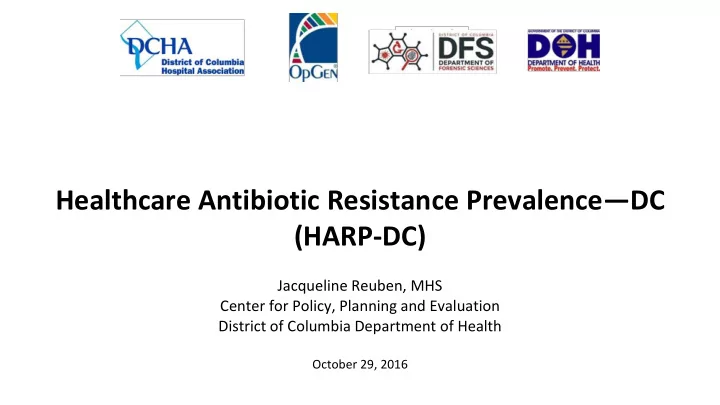

Healthcare Antibiotic Resistance Prevalence — DC (HARP-DC) Jacqueline Reuben, MHS Center for Policy, Planning and Evaluation District of Columbia Department of Health October 29, 2016
Nothing to Disclose
CRE: A Growing Concern • Common • Resistant • Deadly • Spreading 3
Working Together is Vital! 4 Source: http://www.cdc.gov/vitalsigns/stop-spread/
Working Together is Vital for Washington D.C.! • Metropolitan city that is not part of any state • 6 th largest metropolitan statistical area in the U.S. with over 6 million residents • All healthcare facilities clustered within 61 square miles • Also receive patients from MD, VA and international visitors • Competition for market share among facilities that also share patients 5
You Can’t Manage What You Don’t Measure • Colonization among asymptomatic Infected patients common • Identified and unidentified colonized patients serve as reservoir for transmission • Burden of CRE can only be determined Colonized through surveillance cultures • D.C. does not mandate CRE reporting • Healthcare facilities do not routinely conduct CRE surveillance 6
Study Design and Methods 7
Study Design • Study team: – D.C. Department of Health – D.C. Department of Forensic Science – Public Health Lab – District of Columbia Hospital Association – OpGen Laboratories • 16 participating healthcare facilities: – 8 short-term acute care (STAC) – 7 long-term care (LTC) • 2 long-term acute care (LTAC) • 5 skilled nursing facilities (SNF) – 1 inpatient rehabilitation facility (IRF) 8
Study Design • Surveillance conducted over a 1 to 3 day interval for each facility between January 11, 2016 and April 14, 2016 • CDC 2015 CRE surveillance definition • Peri-anal swab samples collected by facility-based volunteers • Independent external review • Verbal consent obtained 9
Study Design • Exclusion criteria: – Psych or ob-gyn patients, inability to consent, or clinically inappropriate • Patient based variables collected: – Age, sex, and zip code • Unit location variables grouped as: – Critical care, step-down units, wards, inpatient rehabilitation, and long-term care (with SNF and LTAC combined) 10
CRE Detection Analyzed at OpGen laboratories 11
HARP-DC Results 12
HARP-DC Results Overview n = 2,217 n = 1,504 n = 1,036 13 * = 6 tests not performed † = 8 tests not performed
Results by Facility and Facility Type Patient Care Type CRE (%) Range (%) Inpatient Rehabilitation 0.0 -- Long Term Care 7.0 0.0-29.4 Short Term Acute Care 5.0 0.0-7.7 -- Critical Care 6.7 0.0-11.6 -- Step down 1.6 0.0-3.7 -- Ward 5.0 0.0-9.5 Total 5.2 0.0-29.4 14
CRE Prevalence by Age Group 9 8.0 8 7 Prevalence (% with CRE) 5.9 5.6 6 5 4 3 2.2 1.8 2 1 0 Age <20 20-39 40-59 60-79 over 79 55 88 285 442 137 n 15
CRE Prevalence by Sex 8 7.1 7 Prevalence (% Resistance) 6 5 4 3.6 3 2 1 p=0.01 0 16 Female Male
CRE Identification by Detection Method Carbapenemase Genes Total Organisms Identified by bla KPC bla NDM bla OXA 48 No Carbapenemase (% of total ID-AST Detected CRE) (culture only) Klebsiella pneumoniae 16 3 19 (35.8) Enterobacter cloacae 6 1 7 (13.2) Escherichia coli 1 3 4 (7.5) Serratia marcescens 1 1 (1.9) Citrobacter sp. 2 2 (3.8) Indeterminant 1 1 (1.9) No growth (gene only) 19 1 19* (35.8) Total (% of total CRE) 44 (83.0) 1 (1.9) 1 (1.9) 8 (15.1) 53* * One sample without growth was positive for both KPC and OXA 48. The total column corrects for the double count. 17
Distribution of Organisms 18
DNA Profiles by Facility 19
HARP-DC Conclusions 20
Strengths • One of few studies to assess regional prevalence that aligns with CDC’s recommended collaborative approach – 4 facility types sampled • Used surveillance cultures rather than clinical cultures – All participating ward types sampled, rather than selecting expected high prevalence areas • Samples obtained from a single peri-anal source rather than multiple source-types • All testing performed with a single molecular/culture method to allow for standardization across sites 21
Limitations • Limited risk factor analysis • Results de-identified • Verbal consent challenges • Selection of peri-anal site – Patient acceptability – Difficulty for patients who were obese, bed-bound, or in chair • Variability in acceptance rate across facilities 22
Conclusions • CRE is endemic in DC facilities, with an average prevalence of 5.2% and wide variation across facilities • Importance of surveillance validated by genotypic profile tending to identify possible CRE transmission within and between facilities • Inpatient healthcare facilities in DC successfully initiated a collaborative approach for further assessment and control efforts • HARP-DC provides a model for other regions to collaborate on MDRO prevalence measurement 23
Thank you! 24
Supplemental Slides
Projected Impact of Coordinated Approach Slayton, Rachel B., et al. "Vital signs: estimated effects of a coordinated approach for action to reduce antibiotic-resistant 26 infections in health care facilities — United States." MMWR. Morbidity and mortality weekly report 64.30 (2015): 826.
Recommend
More recommend